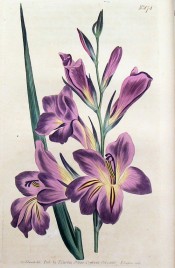Gladiolus communis L. subsp. byzantinus (Mill.) O.Bolòs & Vigo
Hardy, vigorous perennial with spikes of up to 20 funnel-shaped, deep magenta flowers in spring. To 1m. [RHSE, Hortus].
Horticultural & Botanical History
‘This and Gladiolus segetum (supra 719) have usually been accounted varieties of Gladiolus communis (supra 86) but, as appears to us, more from remissness in the observers, than from want of distinctive marks; this a comparison of their specific characters will shew, for which purpose we have subjoined a reformed one of communis. The present species has by far the largest and most ornamental corolla of the three; is a somewhat earlier blower than communis, somewhat shorter, but more robust, and never seeds in our gardens, which both the others do freely. Blooms in June. By the above synonyms seems to have been imported from the neighbourhood of Constantinople.’ [BM t.874/1805].
‘Gladiolus byzantinus has long been cultivated in English and Continental gardens’. [Beal]. Introduced to Britain in 1629. [JD].
History at Camden Park
Listed in the 1845, 1850 and 1857 catalogues [B.124/1845]. Probably introduced by John Bidwill. [See also Gladiolus cardinalis Curt.].
Notes
Gladiolus byzantinus Coss. ex Ball (1878) = Gladiolus illyricus W.D.JKoch, synonym Gladiolus communis L. subsp. illyricus (W.D.J.Koch) O.Bolòs & Vigo
Published Oct 25, 2009 - 10:13 AM | Last updated Aug 05, 2011 - 04:30 PM

Gladiolus communis L. ssp. byzantinus (Mill.) O.Bolòs & Vigo | BM t.874/1805 | RBGS. The flowers figured here are more purple than red.
| Family | Iridaceae |
|---|---|
| Category | |
| Region of origin | Southern Europe to north Africa |
| Synonyms |
|
| Common Name | Byzantine gladiolus, Turkish corn-flag, Greater corn-flag |
| Name in the Camden Park Record | Gladiolus Byzantinus
|
| Confidence level | high |

